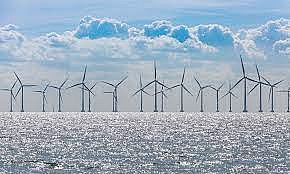GCSE Questions: Energy Sources Q28. The photo shows a large wind farm off the coast of the UK.
The mean power output of the wind farm is 696 MW, which is enough power for 580 000 homes. (a) Calculate the mean power needed for 1 home. Give your answer in watts. 696 MW = 696 000 000 W power per home = 696 000 000/580 000 = 1 200 W [2 marks] (b) On one day the demand for electricity in the UK was 34 000 MW. Suggest two reasons why wind power was not able to meet this demand. Any two from:
[2 marks] (c) Some of the energy from the wind used to rotate a wind turbine is wasted. An engineer oils the mechanical parts of a wind turbine. Explain how oiling would affect the efficiency of the wind turbine. The efficiency of the turbine would increase [3 marks] (d) In most homes in the UK there are many different electrical devices. Explain why people should be encouraged to use energy efficient electrical devices. More efficient devices waste less energy by needing a lower energy input for the same energy output.
[2 marks] (Total 9 marks) |
Follow me...
|






